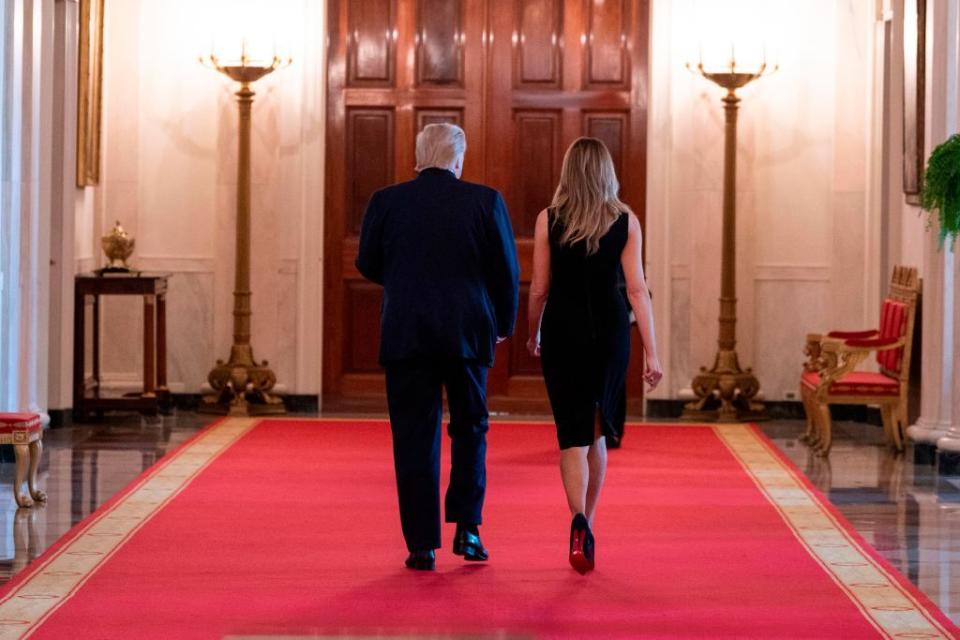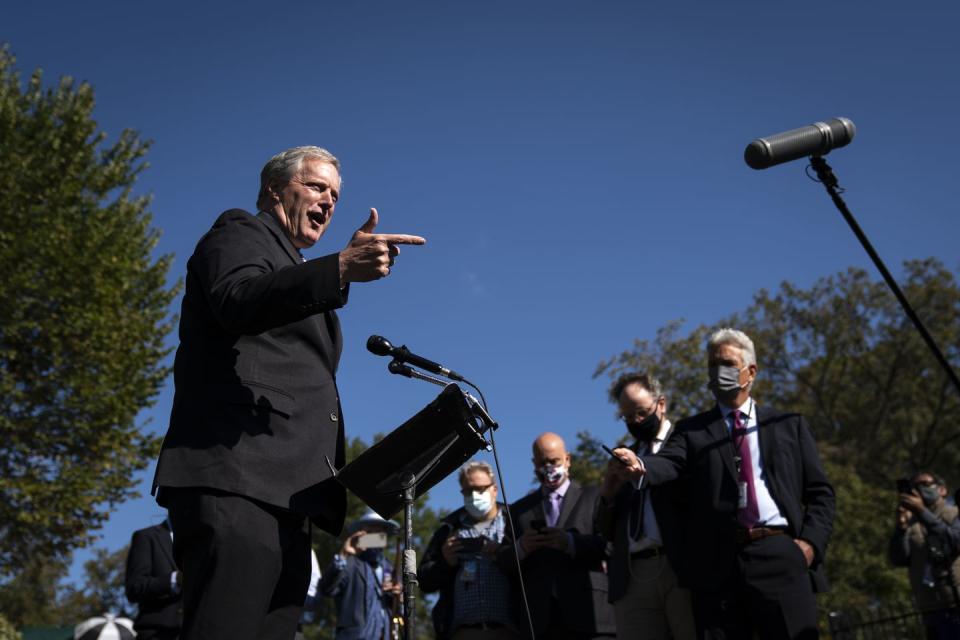What Donald and Melania Trump's Quarantine in the White House Could Look Like

On a normal day in the White House, the President is rubbing shoulders with all manner of guests and West Wing staffers—workers who share surprisingly close quarters—on top of the 100-odd people who run the first family's residence. Now, following Donald and Melania Trump's COVID-19 diagnoses—and the President's days-long hospital stay—they'll have to find a way to completely isolate themselves, if they are to follow their government's own guidelines.
However, it's not clear just what the coming days will look like for the President, or how exactly the First Lady has been self-isolating in the White House since Friday. Below, what we do know about the Trumps' quarantine—and a few educated guesses for what it might look like.
Where will they stay?
The CDC recommends that those who test positive for SARS-CoV-2, the virus that causes COVID-19, isolate themselves in their homes, staying in a room away from other household members and using a separate bathroom, if possible.
The exact precautions that Donald and Melania Trump will be taken haven't been released publicly, but it has been confirmed that the First Lady has been staying residence, and the President plans to return there after his stay at Walter Reed National Military Medical Center.
Which rooms, exactly, they'll be staying in is less clear. The obvious choice is the master suite—a bedroom with an adjoining sitting room and bathroom on the second floor of the residence. However, it's been reported that Melania actually sleeps in a different bedroom, and it's not clear if she'll be isolating with her husband or apart from him.
It's also possible that one or both will choose to spend their quarantine in another room—like the picturesque solarium on the third floor. "It’s this beautiful big room overlooking the south lawn, and it’s very open and airy and has beautiful views of the Washington Monument. It’s essentially like a giant family room," says Kate Andersen Brower, the author of The Residence: Inside the Private World of the White House, adding, "Instead of being locked in their bedrooms all day, that would be a place where they could go."
Although 1600 Pennsylvania Avenue also houses offices for copious staffers in the West Wing (and a smaller amount in the East Wing), it won't be hard for the Trumps to stay out of the way. "It was described to me as being like a Park Avenue apartment. So all of this chaos is going on downstairs, and they are sequestered upstairs," Brower says. "They have a very private world up there," she adds.
White House press secretary Kayleigh McEnany did not respond to Town & Country's request for comment on the President and First Lady's quarantine arrangements—specifically, whether they are isolating together or separately, and what preparations are being made at the residence.

How might White House operations be modified in light of this development?
Normally, around 100 staffers, from florists to butlers, are tasked with looking after the residence. It is possible that this number could be temporarily reduced—for example, Brower believes the dozens of housekeepers could be whittled down to just two—but if the White House has plans to do so, they haven't been made public.
"The chief usher is the one who knows everything that’s going on right now," Brower says, referring to Timothy Harleth, a onetime director of rooms at the Trump International Hotel in Washington, who took on this role in 2017. The chief usher "runs the whole place," in Brower's words, and would be the one tasking staffers with responsibilities like, say, delivering the President's food to his room. (If his food is indeed being delivered—again, the details of Trump's quarantine set-up haven't been shared publicly.)
Normally, two valets and a handful of butlers are the staffers that get the closest to the President—within that six-foot range where experts warn the virus can spread. The valets, in particular, actually help dress him. "That would be the thing that’s the most concerning, the valets and the butlers," Brower says.
Presumably, the President and First Lady will also have to stay away from their 14-year-old son Barron, who lives with them in the residence, and recently tested negative for the disease.
On Sunday, Trump added to the concern that he might not take proper precautions to prevent spreading the virus when he enlisted Secret Service guards to drive him by a crowd of supporters outside Walter Reed. Dr. James P. Phillips, an attending physician at Walter Reed, explained the gravity of the President's decision on Twitter: "Every single person in the vehicle during that completely unnecessary Presidential 'drive-by' just now has to be quarantined for 14 days. They might get sick. They may die. For political theater. Commanded by Trump to put their lives at risk for theater. This is insanity."
Will the President be able to continue working?
In his first statement about Trump's positive coronavirus test on Friday, White House physician Sean Conley wrote that he expected "the President to continue carrying out his duties without disruption while recovering."
The New York Times reported later that day that Trump can use secure communication channels to communicate with military officials and the Pentagon from isolation. The military's Joint Staff said in a statement, "There’s been no change to our alert levels" for American troops.
However, after Conley revealed that Trump had been given supplemental oxygen twice—once on Friday, and once on Saturday—and was being treated with dexamethasone, a steroid only prescribed to those with severe cases of COVID-19, some began to worry that he might be too ill to perform his duties. Likely to combat this perception, the President has continued to release photos of himself at work and videos addressing the public—though he has appeared more energetic in some videos than others, and one photo appeared to show Trump signing a blank sheet of paper.
Still, Politico's Jake Sherman reported that the Map Room and Diplomatic Reception Room in the residence were being prepared to serve as Trump's remote workplace.
West Wing staff have continued to work in their less-than-spacious offices in recent days, despite a growing number of people in Trump's orbit testing positive for the coronavirus—including White House press secretary Kayleigh McEnany and two of her deputies.
Browers notes that, in addition to the warren of offices in the West Wing being cramped quarters—"much smaller than it looks like on TV"—the White House's air circulation isn't exactly top of the line, either. "You have to think about the ventilation system in there," she says. "And there haven’t been a lot of updates to the West Wing. The last major one to the White House was Harry Truman. I mean, this is a very old house, and since 1800 we’ve had presidents living in it. It could use some upkeep."

How long will their quarantine last?
In the case of the First Lady, who's also under Conley's care, the quarantine might not drag on too much longer. Although the White House hasn't clarified how long her isolation will last, according to the CDC's guidelines, those who test positive should stay in quarantine for at least 10 days after his or her symptoms first appeared, and until they have gone at least 24 hours without a fever (without using fever-reducing medicine). In addition to the fever, other symptoms need to be improving as well, though some—like loss of taste and smell—may last for awhile, and don't require isolation. However, she can end her quarantine early if she tests negative for the virus twice in a row, with tests taken at least 24 hours apart.
Trump's isolation, per CDC guidelines, may last significantly longer. Since he was admitted to the hospital and received oxygen, his case is considered "severe," he may be required to stay in quarantine for up to 20 days after his symptoms first appeared—and until he meets the criteria for improving symptoms laid out above. All of this is up to his healthcare provider (in this case, Conley and his staff), and like Melania, he could be given permission to end his isolation if he tests negative twice in a row.
Editor's note: This post has been updated to include information about Trump's hospital stay.
You Might Also Like

